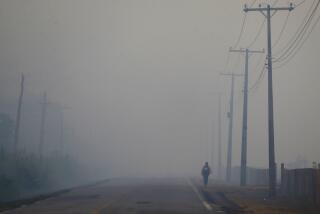World Bank Enters Rain Forest Conservation Effort
- Share via
WASHINGTON — Embarking on a project intended to slow the steady destruction of economically and environmentally valuable tropical rain forests, the World Bank and Brazil unveiled a program Wednesday to nearly triple the amount of Amazon and Atlantic jungle acreage under protection.
But the program, which would put 10% of the Amazon under protection within two years, drew immediate skepticism from environmentalists, who questioned whether Brazil would find the political will to enforce the plan and whether the World Bank would make good on a seemingly open-ended financial commitment.
Rain forests, among the most biologically diverse wilderness areas on Earth, are under assault throughout the tropics--by miners seeking buried minerals, farmers and ranchers clearing land for agriculture, and timber companies and developers.
Preserving the forests requires vast finances, a willingness to stand up to powerful financial and political interests and assistance for indigenous people who depend on them for their livelihoods.
The president of the World Bank, which in recent years has been criticized for putting economic development ahead of environmental protection, offered a commitment to provide “whatever is necessary to meet these needs.”
“We’re taking this on as an extremely serious opportunity,” said James D. Wolfensohn, the bank president.
But the initial contribution by the Global Environmental Facility--an international consortium that includes the World Bank--Brazil and the World Wildlife Fund is just $720,000, a minuscule portion of the $156 million, or possibly much more, that bank officials said might eventually be required.
It is, conceded Robert Buschbacher, director of the World Wildlife Fund’s Brazilian program, “a very small amount.”
The land being preserved under the program is, by some estimates, less than half the amount destroyed since 1975. Just in the past three months, an area of the Amazon the size of Belgium--nearly 12,000 square miles--has been destroyed by fire. And the demand on the forests is increasing drastically.
Over the past 50 years, “lumber use has tripled, paper use has increased sixfold, and firewood use has soared” globally, according to the annual “State of the World” report published by the Washington-based Worldwatch Institute. Two-thirds of the planet’s original forests are gone.
“The timber companies that initially helped deforest much of Southeast Asia and West Africa are now shifting their attention to Latin America,” the report said. And as a result of an ambitious road-building program, the deforested area of the Amazon has increased over roughly two decades--even while land was being set aside in national parks and other preserves--from fewer than 11,000 square miles to about 216,000 square miles, it said.
“The history in the Amazon of protected lands has not been a very happy one,” said Lester R. Brown, president of Worldwatch, an environmental and population research organization.
The heart of the problem, said Brown and others who have studied the assault on the rain forests, is the difficulty of enforcing regulations intended to keep miners, timber companies and others out of vast, lawless areas far from monitors.
Although the land Brazil promised to set aside in just two years is roughly two-thirds the size of the U.S. national park system, Paulo Prado, who runs the Brazilian forestry project of Washington-based Conservation International, said that the acreage was “not a big figure” in the Amazon and that the enforcement effort there “is still very low.”
Under the plan announced at a news conference here Wednesday, 96,000 square miles would be protected, in addition to the 50,000 square miles already listed as protected. According to participants, Brazil, with 30% of the world’s tropical rain forests and 10% of the world’s plant and animal species, has never undertaken such a broad conservation measure.
The need to preserve forests has gained increasing recognition as scientists better understand their contribution to countering effects of global warming by sucking carbon dioxide out of the atmosphere and thus restricting the blanket-like impact that keeps excess solar heat from escaping into the heavens.
As a first step Wednesday, President Fernando Henrique Cardoso of Brazil signed a decree protecting 2,300 square miles in four lots in the Amazon and the Atlantic forest near Rio de Janeiro.
More to Read
Sign up for Essential California
The most important California stories and recommendations in your inbox every morning.
You may occasionally receive promotional content from the Los Angeles Times.









